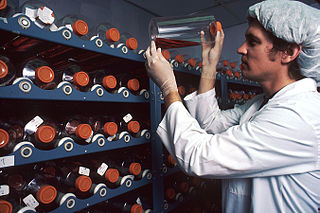An orphan drug is a pharmaceutical agent that is developed to treat certain rare medical conditions. An orphan drug would not be profitable to produce without government assistance, due to the small population of patients affected by the conditions. The conditions that orphan drugs are used to treat are referred to as orphan diseases. The assignment of orphan status to a disease and to drugs developed to treat it is a matter of public policy that depends on the legislation of the country.

James Jude Orbinski, is a Canadian physician, humanitarian activist, author and leading scholar in global health. Orbinski was the 2016-17 Fulbright Visiting professor at the University of California, Irvine, and as of September 1, 2017, he is professor and inaugural director of the Dahdaleh Institute of Global Health Research at York University in Toronto, Ontario, Canada. He was previously the CIGI Chair in Global Health Governance at the Balsillie School of International Affairs and Wilfrid Laurier University (2012-2017), Chair of Global Health at the Dalla Lana School of Public Health (2010-2012) and full professor at the Faculty of Medicine, University of Toronto (2003-2012), where he was the founding Saul Rae Fellow at Massey College. Orbinski's current research interests focus on the health impacts of climate change, medical humanitarianism, intervention strategies around emerging and re-emerging infectious diseases, and global health governance.

The pharmaceutical industry discovers, develops, produces, and markets pharmaceutical drugs for the use as medications to be administered to patients, with the aim to cure and prevent diseases, or alleviate symptoms. Pharmaceutical companies may deal in generic or brand medications and medical devices. They are subject to a variety of laws and regulations that govern the patenting, testing, safety, efficacy using drug testing and marketing of drugs. The global pharmaceuticals market produced treatments worth $1,228.45 billion in 2020 and showed a compound annual growth rate (CAGR) of 1.8%.

Thomas Winfried Menko Pogge is a German philosopher and is the Director of the Global Justice Program and Leitner Professor of Philosophy and International Affairs at Yale University. In addition to his Yale appointment, he is the Research Director of the Centre for the Study of the Mind in Nature at the University of Oslo, a Professorial Research Fellow at the Centre for Applied Philosophy and Public Ethics at Charles Sturt University and Professor of Political Philosophy at the University of Central Lancashire's Centre for Professional Ethics. Pogge is also an editor for social and political philosophy for the Stanford Encyclopedia of Philosophy and a member of the Norwegian Academy of Science and Letters.

Medical research, also known as experimental medicine, encompasses a wide array of research, extending from "basic research", – involving fundamental scientific principles that may apply to a preclinical understanding – to clinical research, which involves studies of people who may be subjects in clinical trials. Within this spectrum is applied research, or translational research, conducted to expand knowledge in the field of medicine.
The pharmaceutical industry is one of the leading industries in the People's Republic of China, covering synthetic chemicals and drugs, prepared Chinese medicines, medical devices, apparatus and instruments, hygiene materials, packing materials, and pharmaceutical machinery. China has the second-largest pharmaceutical market in the world as of 2017 which is worth US$110 billion. China accounts for 20% of the world's population but only a small fraction of the global drug market. China's changing health-care environment is designed to extend basic health insurance to a larger portion of the population and give individuals greater access to products and services. Following the period of change, the pharmaceutical industry is expected to continue its expansion.
The Biodefense and Pandemic Vaccine and Drug Development Act of 2005, nicknamed "Bioshield Two" and sponsored by Senator Richard Burr, aims to shorten the pharmaceutical development process for new vaccines and drugs in case of a pandemic, and to protect vaccine makers and the pharmaceutical industry from legal liability for vaccine injuries. The proposed bill would create a new federal agency, the Biomedical Advanced Research and Development Agency (BARDA), that would act "as the single point of authority" to promote advanced research and development of drugs and vaccines in response to bioterrorism and natural disease outbreaks, while shielding the agency from public Freedom of Information Act (FOIA) requests. BARDA would be exempt from long-standing open records and meetings laws that apply to most government departments.
The pharmaceutical industry in India was valued at an estimated US$42 billion in 2021 and is estimated to reach $130 billion by 2030. India is the world's largest provider of generic medicines by volume, with a 20% share of total global pharmaceutical exports. It is also the largest vaccine supplier in the world by volume, accounting for more than 60% of all vaccines manufactured in the world. Indian pharmaceutical products are exported to various regulated markets including the US, UK, European Union and Canada.

James Packard Love is the director of Knowledge Ecology International, formerly known as the Consumer Project on Technology, a non-governmental organization with offices in Washington, D.C., and Geneva, that works mainly on matters concerning knowledge management and governance, including intellectual property policy and practice and innovation policy, particularly as they relate to health care and access to knowledge.
Humanitarian use licenses are provisions in a license whereby inventors and technology suppliers protect in advance the possibility of sharing their technology with people in need. Thus, humanitarian use licenses set the conditions for the provision of access to innovations for people in need at a royalty free basis or at lower costs. Humanitarian use licenses assure that products of research and development stay publicly available and that at the same time the incentive function of exclusive intellectual property rights are maintained.
Pharmaceutical policy is a branch of health policy that deals with the development, provision and use of medications within a health care system. It embraces drugs, biologics, vaccines and natural health products.
Legal scholars, economists, activists, policymakers, industries, and trade organizations have held differing views on patents and engaged in contentious debates on the subject. Critical perspectives emerged in the nineteenth century that were especially based on the principles of free trade. Contemporary criticisms have echoed those arguments, claiming that patents block innovation and waste resources that could otherwise be used productively, and also block access to an increasingly important "commons" of enabling technologies, apply a "one size fits all" model to industries with differing needs, that is especially unproductive for industries other than chemicals and pharmaceuticals and especially unproductive for the software industry. Enforcement by patent trolls of poor quality patents has led to criticism of the patent office as well as the system itself. Patents on pharmaceuticals have also been a particular focus of criticism, as the high prices they enable puts life-saving drugs out of reach of many people. Alternatives to patents have been proposed, such Joseph Stiglitz's suggestion of providing "prize money" as a substitute for the lost profits associated with abstaining from the monopoly given by a patent.
Medication costs, also known as drug costs are a common health care cost for many people and health care systems. Prescription costs are the costs to the end consumer. Medication costs are influenced by multiple factors such as patents, stakeholder influence, and marketing expenses. A number of countries including Canada, parts of Europe, and Brazil use external reference pricing as a means to compare drug prices and to determine a base price for a particular medication. Other countries use pharmacoeconomics, which looks at the cost/benefit of a product in terms of quality of life, alternative treatments, and cost reduction or avoidance in other parts of the health care system. Structures like the UK's National Institute for Health and Clinical Excellence and to a lesser extent Canada's Common Drug Review evaluate products in this way.
Some authors advocating patent reform have proposed the use of prizes as an alternative to patents. Critics of the current patent system, such as Joseph E. Stiglitz, say that patents fail to provide incentives for innovations which are not commercially marketable. Stiglitz provides the idea of prizes instead of patents to be awarded in order to further advance solutions to global problems such as AIDS.
Pharmaceutical innovations are currently guided by a patent system, the patent system protects the innovator of medicines for a period of time. The patent system does not currently stimulate innovation or pricing that provides access to medicine for those who need it the most, It provides for profitable innovation. As of 2014 about $140 Billion is spent on research and development of pharmaceuticals which produces 25–35 new drugs annually. Technology, which is transforming science, medicine, and research tools has increased the speed at which we can analyze data but we currently still must test the products which is a lengthy process. Differences in the performance of medical care may be due to variation in the introduction and circulation of pharmaceutical innovations.
Access to medicines refers to the reasonable ability for people to get needed medicines required to achieve health. Such access is deemed to be part of the right to health as supported by international law since 1946.
The US carries out 46% of global research and development (R&D) in the life sciences, making it the world leader in medical research.

Louis Preston Garrison Jr. is an American health economist who has made significant contributions to pharmacoeconomics, pharmacogenomics and personalized medicine, regulatory benefit-risk analysis, insurance, pricing, reimbursement and risk-sharing agreements. He also made numerous contributions on the economic evaluation of pharmaceuticals, diagnostics, devices, surgical procedures, and vaccines, particularly as related to organ transplantation, influenza, measles, obesity, and cancer. Garrison has published over a hundred manuscripts in peer-reviewed journals and contributed to several book chapters.

Vaccine development and production is economically complex and prone to market failure. Many of the diseases most demanding a vaccine, including HIV, malaria and tuberculosis, exist principally in poor countries. Pharmaceutical firms and biotechnology companies have little incentive to develop vaccines for these diseases because there is little revenue potential. Even in more affluent countries, financial returns are usually minimal and the financial and other risks are great.

Proprietary drug are chemicals used for medicinal purposes which are formulated or manufactured under a name protected from competition through trademark or patent. The invented drug is usually still considered proprietary even if the patent expired. When a patent expires, generic drugs may be developed and released legally. Some international and national governmental organizations have set up laws to enforce intellectual property to protect proprietary drugs, but some also highlight the importance of public health disregarding legal regulations. Proprietary drugs affect the world in various aspects including medicine, public health and economy.







